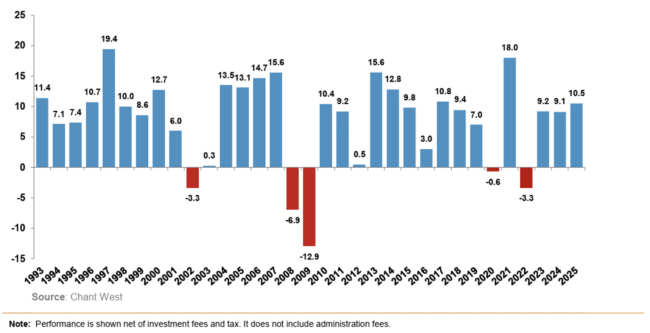You’re ultimately responsible for the investment performance. So, how can you determine whether you’re cutting it as an investment manager? And what should you do if you’re not?
If you’re the trustee of a self-managed super fund (SMSF), you’re required to manage the monies in accordance with your members’ instructions, whether this is you alone, or with your partner and family. With this responsibility comes an onus to say whether you’re doing a decent job or not as an investment manager.
And even if you have outsourced the investment functions to an adviser, you’re ultimately responsible for the investment performance. So, how can you determine whether you are cutting it as an investment manager?
One way is to simply compare the fund’s performance to the fund’s investment objective(s). If, for example, your objective is to deliver a return of inflation plus 3.5% over a 10-year period, then if your fund has been growing at 7% pa over this period, then give yourself a tick.
The problem with this method is that your objective might be unrealistic. Given the level of risk you’re taking, it may be too tough. Conversely, you might have set the bar too low.
A more direct method is to compare your fund’s performance to that achieved by the major industry and retail super funds. After all, if you closed your SMSF, this is where the monies would go. So, how has the industry performed?
Super fund returns in 2024/25
Due to the performance of the share market, in particular overseas shares, most super funds will report positive returns for 24/25. According to industry research group Chant West, the median public offer ‘growth’ fund delivered a return of 10.5% for the year.
Since the introduction of compulsory super in July 1992, growth funds have experienced negative yearly returns on five occasions, the last in 21/22. For the 33 completed years, this is a ratio of 1 in 6 years, better than the risk expected frequency of 1 in every 5 years. The chart below shows financial year by financial year performance.
Growth Funds – Financial Year Returns since 1983

The best year was 1996/1997 with a return of 19.4%, the worst, the GFC year of 2008/09, a loss of 12.9%. The average return over this period is 8%.
Super investment options are typically classified according to the percentage of growth style assets they target. Growth assets are those where a major part of the return is expected to come from an appreciation in the price of the asset, and includes shares, international shares, property, private equity, infrastructure, commodities and collectables. Income assets are cash, term deposits and interest rate securities such as bonds, private credit, mortgages and hybrid securities.
Growth assets will typically deliver higher investment returns, but with more volatility and a higher probability of a negative return. Income assets will typically deliver lower investment returns, but with lower volatility.
Table 1 shows the median returns from 1 year to 15 years of different super investment options categorized according to the percentage of growth assets. As you would expect, returns for ‘balanced’ and ‘conservative’ options are lower than the returns for ‘growth’ and ‘high growth’ style options.

The returns are after investment fees (but not administration fees) and after tax (assumed to be at a rate of 15%). Funds in pension mode, which aren’t paying tax, would have higher investment returns.
There is a ‘question mark’ about the returns of super funds which hold significant investments in unlisted assets, such as commercial buildings, private equity or infrastructure. While these assets are valued by independent valuers, it is not a particularly transparent process and there is often a lag between valuations in traded markets and valuations for illiquid assets.
How can you compare, and over what timeframe?
The first step is to categorize your fund by asset mix (i.e. high growth, growth, balanced or conservative), and then whether it is in accumulation or pension. Whether you use a target asset allocation or the actual allocation on 30 June doesn’t matter that much, we are really just after an approximate benchmark.
Next, determine your fund’s performance for the financial year. This usually can’t be done until you have all the tax information and can lodge your annual SMSF return and may require the help of your accountant or administrator. Most SMSF software packages can calculate investment returns, so don’t be put off if your accountant tries to give you the brush on this. And remember that to compare like with like, we are looking at returns after tax and investment/administration costs. So, if you are doing the calculation manually, don’t forget to add back the franking credit refunds and deduct the administration costs.
What time period to compare to the industry benchmark? Let’s start with a one year horizon, but clearly no one gets fired for marginal underperformance over such a short period. See if you can extract data for previous years, and compare the returns over 3 years, 5 years and potentially even longer.
What should you do if your performance falls short?
The first task is to understand why you have underperformed. Two potential scenarios are that your mix of growth assets is different to the target or normalized allocation, or secondly, the individual assets you selected have underperformed compared to the overall asset class.
Table 2 shows the performance of the major asset classes over the periods to 30 June 25 (sources S&P, Bloomberg, Morningstar, MSCI).

The “star” asset class last year was international shares, and if your SMSF was underweight international shares, then you may have underperformed last year. Interestingly, international shares have outperformed Australian shares over most time periods.
The other notable standout from the data is the poor performance of Australian bonds over 5 and 10 years. While performance improved in 24/25 to 6.8%, thanks to a decline in yields, the negative return in 21/22 when interest rates moved higher means that the five year return is still negative and over 10 years, the average return is only 2.3% pa.
If your asset class mix was in line with the target, but you still didn’t perform, that points to issues relating to how you allocate across sectors and to individual securities.
And if your performance is consistently falling short?
If you aren’t cutting it as an investment manager, then you should probably wind up your SMSF and transfer your super to an industry fund. Alternatively, engage an adviser to help you.

